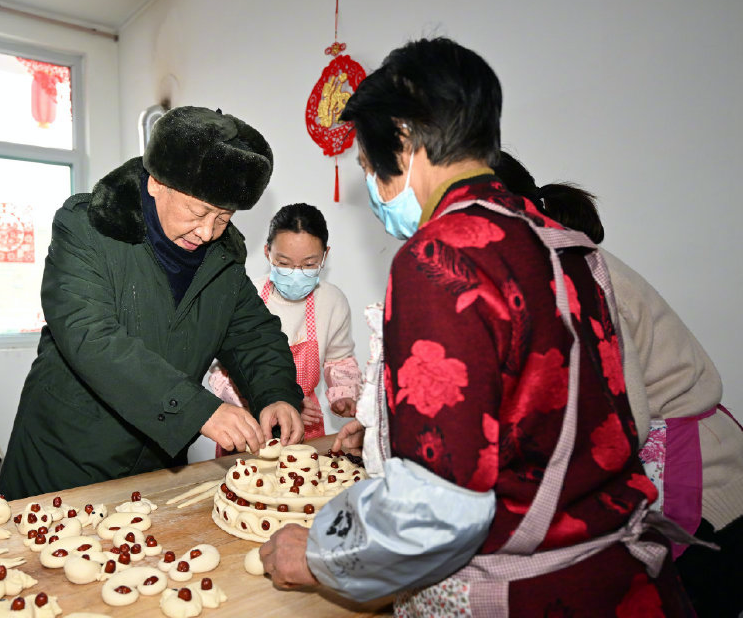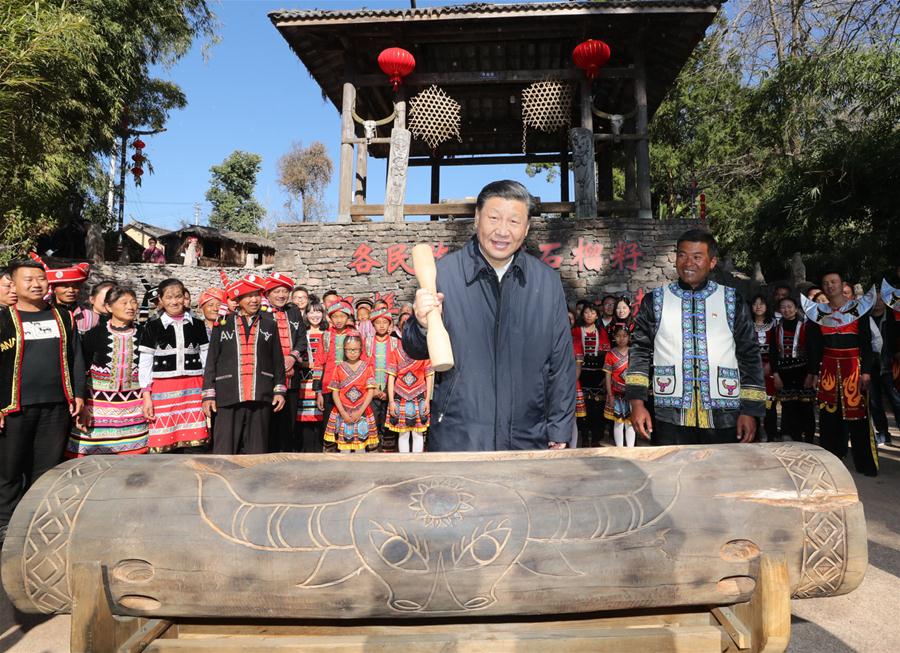Published: January 16,2023
By XU WEI,YANG JUN and SUN RUISHENG

President Xi Jinping makes huamo, or decorated steamed buns, with villagers in Linfen, North China’s Shanxi province, on Jan 26, 2022. [Photo/Xinhua]
President’s trips show his great attention to disadvantaged groups, ethnic unit
The days leading up to Spring Festival, China’s biggest holiday, are a time for many people to travel and busily prepare for family reunions.
For President Xi Jinping, it is a time to convey messages of good wishes to the people, offer support to disadvantaged groups and promote ethnic unity.
Xi, who is also general secretary of the Communist Party of China Central Committee and chairman of the Central Military Commission, has made fact-finding trips for 10 consecutive years to various provincial-level regions days before the Lunar New Year, sitting down with people in their homes, inquiring about their living conditions and soliciting advice over policies.
Rural areas have always topped the agenda for Xi’s tours ahead of the Lunar New Year.
Han Qiang, dean of the School of Marxism at Beijing Foreign Studies University, said the priority Xi has given to rural and remote regions in his domestic trips ahead of Spring Festival is in keeping with the CPC’s traditional emphasis on agriculture, rural areas and the well-being of farmers.
“Rural areas remain the most challenging part in the nation’s drive to build a modern socialist nation,” he said. “For the Party, the issue of agriculture, rural development and farmers is closely related to food security, social stability and economic growth.”

President Xi Jinping visits Duancun village in Fenxi county in Shanxi province on Jan 26, 2022. [Photo/Xinhua]
Last year, two villages in Shanxi province were the first stops of Xi’s annual festive tour, where he called on rural households amid freezing temperatures and flurries of snow.
Cai Wenming, a 63-year-old farmer from Duancun, a village in Fenxi county in Shanxi, can still remember every detail of Xi’s visit to his home one year on.
He recalled that Xi went to the kitchen first and saw what the family had prepared for the New Year. “He could identify most of the local food on the table and even name the ingredients. I was surprised by his high level of familiarity with rural life.”
The president also turned on the tap water to inspect its quality, looked at the sheep being raised by the family and inquired about their annual income.
“I wasn’t nervous at all speaking with him. He made it easy for us. It was a half-hour of my life that I will never forget,” he said.
Between 2013 and 2022, Xi has visited rural families in Gansu, Shaanxi, Jiangxi, Hebei, Sichuan, Yunnan, Guizhou and Shanxi provinces and the Inner Mongolia autonomous region, underscoring the Party’s unwavering commitment to poverty alleviation and boosting rural development.
Another priority for Xi’s festive trips is to visit families that have been affected by natural disasters such as earthquakes and floods.
In Shanxi, he visited the home of a family that had been hit by floods in 2021 and learned about their living conditions. In 2018, he visited Yingxiu, a township in Wenchuan county of Sichuan province, the epicenter of a major earthquake that killed tens of thousands in 2008.
Han said that Xi’s visits to disaster-hit families before the Spring Festival showed the strong level of support from the top leadership when the families needed it the most.
“Such visits would also spur the authorities to extend greater support to the families and help them solve their difficult problems,” he said.

President Xi Jinping gets ready to beat a wooden drum of the Wa ethnic group during a visit to the Simola Wa village in Qingshui township of the city of Tengchong, Southwest China’s Yunnan province, on Jan 19, 2020. [Photo/Xinhua]
China’s ethnic minority groups are another focus of Xi’s festive trips.
The president sat down with herdsmen from the Mongolian ethnic group in a traditional yurt during a trip to Inner Mongolia in 2014. He also sat by the fireplace with villagers from the Yi ethnic group as he toured Sichuan province in 2018, and he made some traditional food of the Wa ethnic group in Yunnan days before the Spring Festival in 2020.
During the trips, he vowed that the nation would leave no one and no ethnic group behind in its poverty alleviation drive — a campaign that eventually lifted all of China’s impoverished population, including 31.21 million poor people living in ethnic minority regions, out of absolute poverty by the end of 2020.
Greater ethnic unity and stronger efforts to pass down the cultural heritage of ethnic groups are also among the key messages conveyed by the president during his inspection tours.

President Xi Jinping makes Huangba, a local dessert made of sticky rice, with villagers of Huawu village in Xinren Miao township of Qianxi county, Bijie, Southwest China’s Guizhouprovince, on Feb 3, 2021. [Photo/Xinhua]
Xi’s tours have advocated greater ethnic unity and pushed forward the development of regions predominantly inhabited by ethnic minority groups, said Han. “Ensuring ethnic unity is key part of efforts to safeguard the nation’s fundamental interests. Trips by the president to ethnic minority regions help the nation develop better ethnic policies and expedite the growth of the regions.”
Xi’s visit to Huawu, a village of the Miao ethnic group in Qianxi, Guizhou province, ahead of the Lunar New Year in 2021 has profoundly reshaped the lives of Yang Wenli and her fellow villagers.
Yang said the village was only connected to the outside world by road in 2008. Before that, no vehicle had ever arrived in the village.
During Xi’s visit to Huawu, Yang briefed the president on the traditional folk art in her workshop, including the traditional clothing of the ethnic group and her products.”The president said the splendor of the art was produced stitch by stitch. He tried to give us greater confidence in our own culture and what we were doing,” Yang said.
Xi told Yang and her fellow workers that ethnic folk arts can win global popularity, and greater efforts must be made to carry forward and develop traditional folk culture.
“It was the most fortunate and the happiest moment of my life,” Yang said while recalling the visit.
Xi’s visit has given greater publicity to Miao embroidery and the products from Yang’s workshop, which now employs 22 villagers.
Yang and her employees have now taken to livestreaming platforms to promote their Miao embroidery, and the workshop can generate an average sales volume of 80,000 yuan ($11,900) for each online event.
“I never realized there was so much value in what I was doing before I met the president. In the future, I want to take our handmade products to the global market,” she said.
China Daily
 Africa -China Review Africa -China Cooperation and Transformation
Africa -China Review Africa -China Cooperation and Transformation
